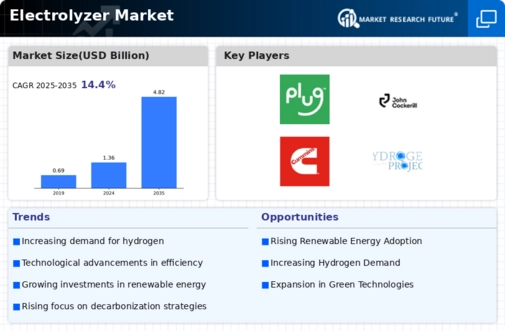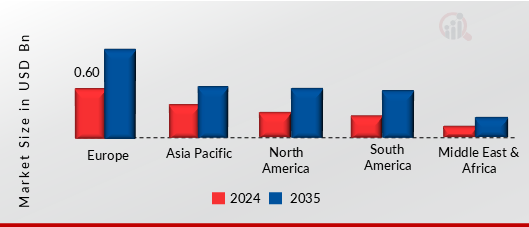Market Growth Projections
The Global Electrolyzer Market Industry is projected to experience substantial growth over the next decade. With the market valued at 1.36 USD Billion in 2024, it is expected to reach 4.82 USD Billion by 2035. This growth trajectory indicates a compound annual growth rate of 12.19% from 2025 to 2035. Such projections highlight the increasing recognition of electrolyzers as a pivotal technology in the transition to a hydrogen economy. The anticipated expansion reflects the convergence of various factors, including technological advancements, government support, and rising demand for sustainable energy solutions.
Growing Demand for Green Hydrogen
The Global Electrolyzer Market Industry is experiencing a surge in demand for green hydrogen, driven by the global transition towards sustainable energy sources. Countries are increasingly investing in hydrogen production as a clean alternative to fossil fuels. For instance, the European Union has set ambitious targets for hydrogen production, aiming for 10 million tons of renewable hydrogen by 2030. This shift is expected to propel the market, with projections indicating that the industry will reach 1.36 USD Billion in 2024 and expand to 4.82 USD Billion by 2035, reflecting a compound annual growth rate of 12.19% from 2025 to 2035.
Government Initiatives and Policies
Government initiatives and policies play a crucial role in shaping the Global Electrolyzer Market Industry. Various nations are implementing supportive regulations and funding programs to promote hydrogen technologies. For example, the United States has introduced tax incentives for hydrogen production and infrastructure development. Such measures not only enhance the economic viability of electrolyzers but also stimulate research and development. As a result, the market is likely to witness accelerated growth, with the anticipated increase in investments and policy support fostering innovation and adoption of electrolyzer technologies.
Rising Investment in Renewable Energy
The rising investment in renewable energy sources is a key driver for the Global Electrolyzer Market Industry. As countries strive to meet their climate goals, investments in solar and wind energy are surging. Electrolyzers are integral to utilizing excess renewable energy for hydrogen production, thereby addressing energy storage challenges. For instance, countries like Germany and Australia are investing heavily in renewable energy projects that incorporate electrolyzer technology. This trend is expected to bolster the market, with projections indicating a robust growth trajectory as the integration of electrolyzers into renewable energy systems becomes more prevalent.
Increasing Industrial Applications of Hydrogen
The increasing industrial applications of hydrogen are propelling the Global Electrolyzer Market Industry forward. Industries such as chemicals, refining, and steel production are exploring hydrogen as a cleaner alternative to conventional processes. For example, hydrogen is being utilized in ammonia production, which is essential for fertilizers. The shift towards hydrogen in these sectors not only reduces carbon emissions but also enhances energy efficiency. As industries adopt hydrogen solutions, the demand for electrolyzers is likely to rise, contributing to the overall growth of the market in the coming years.
Technological Advancements in Electrolyzer Design
Technological advancements in electrolyzer design are significantly influencing the Global Electrolyzer Market Industry. Innovations such as improved membrane materials and advanced catalysts are enhancing the efficiency and durability of electrolyzers. For instance, the development of proton exchange membrane electrolyzers has shown promise in achieving higher hydrogen production rates. These advancements not only reduce operational costs but also make electrolyzers more competitive against traditional hydrogen production methods. Consequently, the market is poised for growth as these technologies become more widely adopted, aligning with the increasing demand for efficient hydrogen production.






